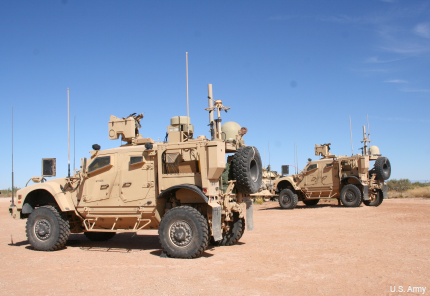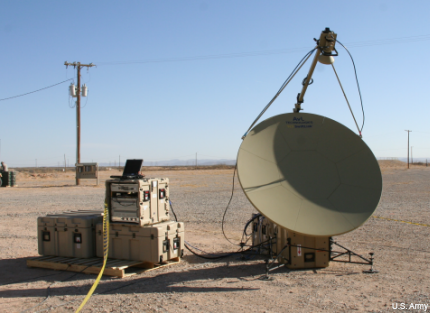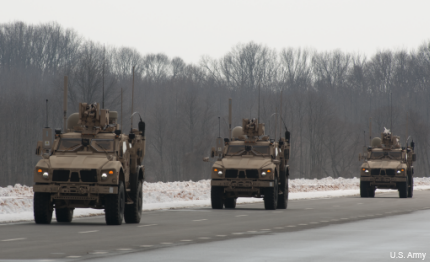How the Army is building a better battlefield network
WIN-T, the centerpiece for the service's mobile tactical communications, rolls on in face of fiscal realities.

WIN-T Increment 2-equipped vehicles bring communications to soldiers on the move.
The Army has been working for years to extend the network all the way to the front lines, and despite a constrained environment, modernization of its tactical network remains a high priority, according to service officials. The cornerstone of the Army’s mobile battlefield network is the Warfighter Information Network-Tactical (WIN-T), which provides mission-critical voice, video and data to soldiers who are on-the-move in combat vehicles.
With U.S. forces in Afghanistan and the Army's overall force structure continuing to draw down, the service is working to balance equipment modernization needs and affordability as DOD and the Army confront long-term budgetary challenges. Funding of WIN-T Increment 2, an initial networking on-the-move capability, is being aligned with the pace of Army modernization as well as how many units are fielded and upgraded annually in alignment with the Army Force Generation process. At the same time, some of the requirements for WIN-T Increment 3, the full networking on-the-move capability, are being deferred due to the current austere budgets.
“We are continuing to field WIN-T in accordance with Army network modernization priorities,” said Col. Ed Swanson, project manager for WIN-T. “If those requirements are reduced, then the funding will be reduced and less equipment will be procured and produced annually.”
Forged in combat
After more than a decade of supporting Operation Iraqi Freedom and Operation Enduring Freedom, WIN-T’s capabilities are currently being enhanced through improvements based on feedback from deployed soldiers using the system in Afghanistan and recommendations from recent Network Integration Evaluations.
“WIN-T is a critical component to the Army's tactical network modernization strategy as we field new capabilities to fill existing gaps and upgrade products that have already been fielded,” Swanson said. “One of the program's main focus areas will be making the equipment easier to install, operate, maintain and support.”
Increment 1, providing data, voice and video communications at-the-quick-halt, or the battalion level, began fielding in 2004 to meet an urgent operational need and has since been delivered to 210 active duty, reserve and National Guard units. Currently, Increment 1 is undergoing an upgrade—Increment 1B—that adds a number of important capabilities from Increment 2 (company level) to enhance interoperability while adding capability.
The 1B upgrades add the “colorless core architecture” to increase both security and bandwidth efficiency, while also adding the dynamic Network Centric Waveform (NCW) modem that Increment 2 uses to optimize bandwidth and satellite utilization. The upgrades will be completed in 2017 and they will continue to be a critical part of the Army's backbone tactical network for the foreseeable future.
With Increment 1 fully fielded, Increment 2 is emerging as the mobile, secure communications backbone of the soldier's network and the linchpin of the Army's network modernization plan.
“While Increment 1 brought a much needed beyond-line-of-sight satellite communications capability to the battalion level for the first time, the units had to come to a halt to set up the equipment and
communicate,” Swanson said. “Increment 2 brings an on-the-move capability to the tactical network and extends the WIN-T connectivity and BLOS SATCOM capability to the company level for the first time. Communications connectivity is uninterrupted, whether operating at the quick halt or on-the-move.”

During training earlier this year, soldiers got their first look at Tropo Lite, a tropospheric scatter communications system.
Increment 2 is targeted to field to the maneuver units that require an on-the-move capability that is optimized to support offensive operations, he said. While Increment 1 has been fielded to 210 Army units, Chris Marzilli, president of General
Dynamics C4 Systems, prime contractor for WIN-T, said that Increment 2 will be fielded to a little more than 100 units. Currently supporting Capability Set fielding, Increment 2 is deployed in support of Operation Enduring Freedom and has been fielded to three Division Headquarters and six Brigade Combat Teams.
“WIN-T is the centerpiece for the Capability Set fielding strategy and makes up a considerable portion of the Army's mission command portfolio,” Swanson said. “Deploying units are usually the highest priority. For example, the first Increment 2 Capability Set 13 units all deployed shortly after completing their New Equipment Training and New Equipment Fielding.”
Though the deployed Army units with Increment 2 equipment are operating primarily in a security assistance mission to support Afghan National Security Forces, he said most of the feedback from soldiers has been positive, with Increment 2 in Afghanistan providing reliable communications to units dispersed hundreds of kilometers apart in extremely rugged terrain. Its capabilities have also allowed coalition forces to keep "warm bases" by using a small amount of Increment 2 equipment to communicate instead of deploying much more equipment and personnel to accomplish the same thing.
“The Increment 2 program continues to improve system reliability, simplify the network and network operations and increase capabilities, all driven by critical soldier feedback,” Swanson said.
Increment 2’s Points of Presence (PoPs) and Soldier Network Extensions (SNEs) have been particularly effective by providing satellite communications to Army units that are operating outside of the Forward Operating Bases for extended periods of time conducting missions such as route clearance, security assistance and election support. The PoPs and SNEs provide these geographically dispersed units with continuous satellite voice telephone services, secure Internet, chat and e-mail, live surveillance feeds and reach-back to tactical internet servers and SharePoint sites.
“The SNE is the first time that they fielded an Internet spigot at the company level,” said General Dynamics’ Marzilli. “At the company level, that’s where these guys are very forward-deployed and under fire. So, you need to make sure they have a reliable technology capability that they don’t have the time or the personnel to worry about.”
Learning from NIEs, testing
Increment 2 enhancements are being assessed during two intensive developmental tests. The first was completed in late February 2014 at the Aberdeen Test Center at Aberdeen Proving Ground, Md., with soldiers putting a large part of a brigade’s worth of equipment through its paces in a tactical environment. The test was designed primarily to demonstrate and evaluate the effectiveness of usability improvements for the SNE and PoP. Marked improvements in the PoP, SNE and Combat Net Radio (CNR) Gateway were tested and demonstrated during the test, with positive soldier feedback.
“Some of the focus areas were start-up time, shut-down time, Combat Net Radio Gateway operations, troubleshooting tools and user interfaces,” Swanson said. “The results demonstrated that considerable improvements have been made to make the SNEs and PoPs easier to install, operate, maintain and support.”

The Army is improving WIN-T through soldier feedback and a series of tests and evaluations.
The second developmental test is scheduled for June at Fort Bliss, Texas. It will focus on evaluating the reliability improvements for the SNE and PoP made since the Follow-On Operational Test and Evaluation in May 2013. During that evaluation, more than 3,800 soldiers from the 2nd Brigade Combat Team, 1st Armored Division conducted a wide range of on-the-move military and peacekeeping operations, both day and night, using the WIN-T Increment 2 system.
In June at Fort Bliss, dozens of hardware and software reliability improvements that have been implemented will be tested, and a Stryker battalion will be integrated with Increment 2 equipment for the first time to evaluate network performance on that platform.
According to Swanson, it is notable that the Army will have soldiers from Fort Bragg, Fort Campbell and Fort Drum supporting the test, which will include realistic operational threads, data collectors and instrumentation similar to the operational test. “We expect to learn a lot on the improvements made in the areas of operational effectiveness and suitability to inform our readiness for the FOT&E2,” he said.
The semi-annual NIEs are a key component of the Army's modernization efforts, designed to assess capabilities and integrate and mature the Army's tactical network. NIE 14.1 was conducted in October 2013 at Fort Bliss with Increment 2-equipped vehicles part of the evaluations.
“We leveraged 14.1 to demonstrate a number of new capabilities,” Swanson said. “Increment 2 integrated some of their configuration items, the SNE and PoP, on new platforms to include a Stryker vehicle, a M1068 [Standard Integrated Command Post System] and a M113 [armored personnel carrier].”
One of the new Increment 1 technologies evaluated at NIE 14.2 was Tropo Lite, a transit case-based tropospheric scatter communications system. The Signal Modernization program is also delivering a number of other innovative technologies to the Army's Expeditionary Signal Battalions that significantly increase the bandwidth to command posts and untether the users. These were demonstrated at NIE 14.2 and include 4G LTE Cellular, Command Post Wireless (Wi-Fi), a new Terrestrial Transmission System, and Mission Network Enclave with Radio Bridging and Voice Cross Banding.
“All of these systems will significantly increase the bandwidth available to command posts as well as to individual users, while reducing many of the Ethernet cables and allowing them to roam wirelessly,” Swanson said. “The Increment 1 program office is demonstrating a number of these capabilities using the 86th Expeditionary Signal Battalion located at Fort Bliss.”
Increment 3 also had a couple demonstrations at NIE 14.2. One involved the Conditions Based Maintenance Plus (CBM+) capability to improve equipment readiness and preventive maintenance. The benefit of CBM+ is the ability to push network status data to the Command Post of the Future, allowing the Signal Soldier to share top-level network status with a commander and other staff members in near-real time. Another Increment 3 demo is a follow-on to the 14.1 transport convergence effort, but this time a realistic representative intelligence network load was placed on the WIN-T network to assess the ability of the WIN-T backbone to support both mission command and intelligence on a shared network.
At NIE 15.1 in October and November 2014, Increment 2 is scheduled for Follow-on Operational Test & Evaluation 2, whose purpose is to evaluate a few areas that were assessed as not effective or suitable during previous operational tests. The three focus areas are: to continue to improve the reliability of the PoPs and SNEs; significantly reduce the startup/shutdown times of the PoPs and SNEs; and significantly improve the CNR user interface.
Aerial layer on hold
Though Increment 3 will ultimately improve throughput for line-of-sight and beyond-line-of-sight transmissions through the development of the Highband Networking Waveform (HNW), Swanson said that fiscal realities have forced a delay of the Increment 3 aerial layer.
“The air tier and WIN-T Communication Payload, which is part of the Increment 3 program, is being deferred,” he said. “Both the Increment 1 and Increment 2 programs are stand-alone communications networks and architectures that contain both a terrestrial and celestial tier. The Increment 3 air tier adds capacity, reliability and lessened dependence on satellite communications. The Army values the capabilities that the air tier will bring, and will pursue in another program sometime in the future.”
Increment 3 is focusing on the development of Network Operations (NetOps) capabilities and upgrades to both the LOS NCW and the BLOS HNW. NetOps is a suite of tools that allows a unit’s S6/G6 communications soldiers to plan, configure, initiate, manage, monitor, control and defend the network. Although developed by Increment 3, the NetOps capabilities will be procured and inserted into both Increment 1 and Increment 2 units, providing all WIN-T units with a common suite of NetOps tools that increases interoperability.
“The new NCW will significantly increase BLOS capacity while using the same hardware modem that both Increment 2 and Increment 1B are fielding,” Swanson said. “The new HNW will undergo an over-the-air demonstration and then be placed into the Joint Tactical Network Center repository for potential use by other Army and OSD programs.”
General Dynamics’ Marzilli said the Army believes the aerial layer is still a valid requirement but has “put it on the back burner” in order to focus on NetOps. “What you’re seeing are the natural adjustments,” he said. “The Army is coming down from two theaters of war after 12 years of being engaged in a fight. And, so, they’re coming back to home station and figuring out how they’re going to reconstitute the force structure.”